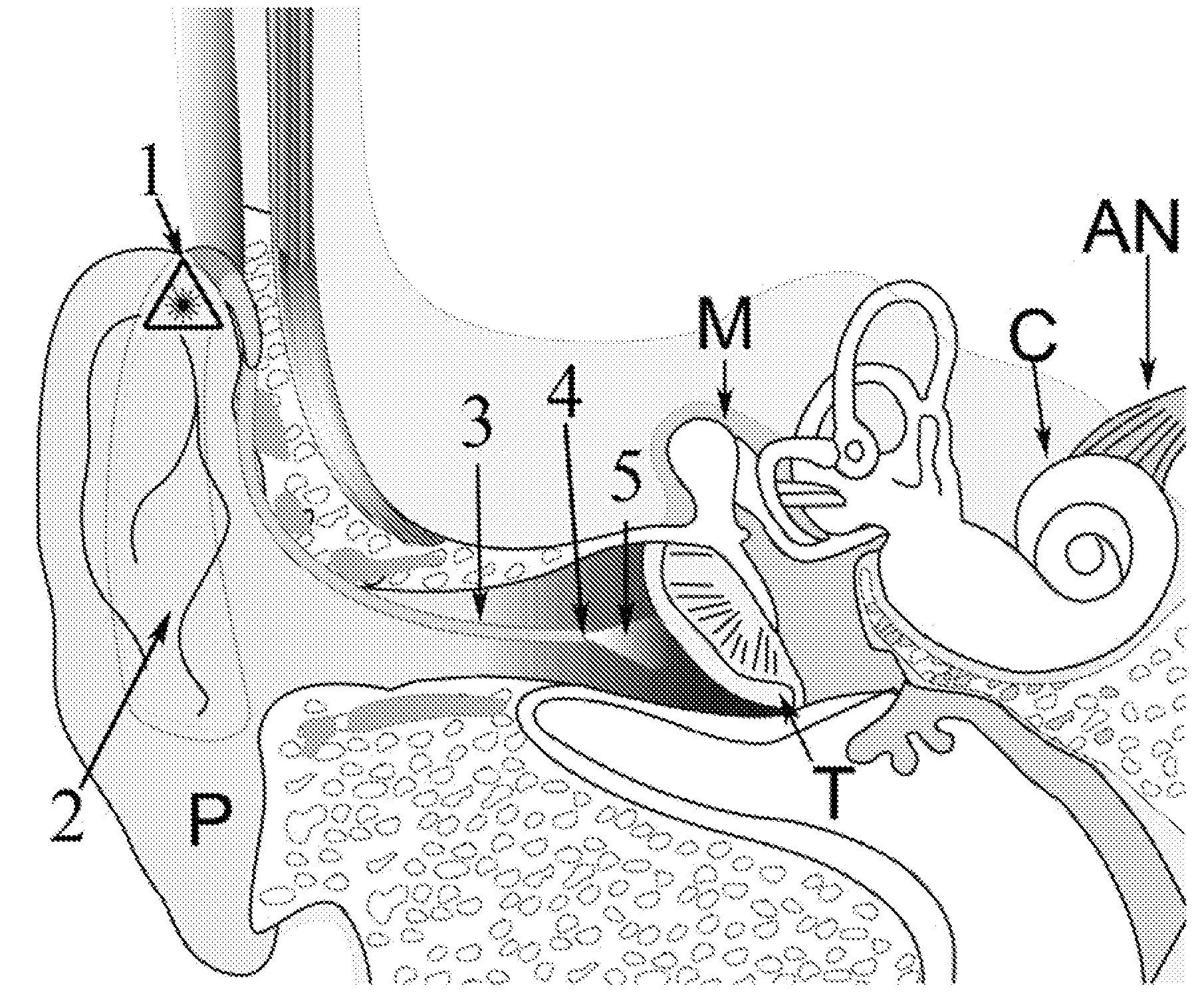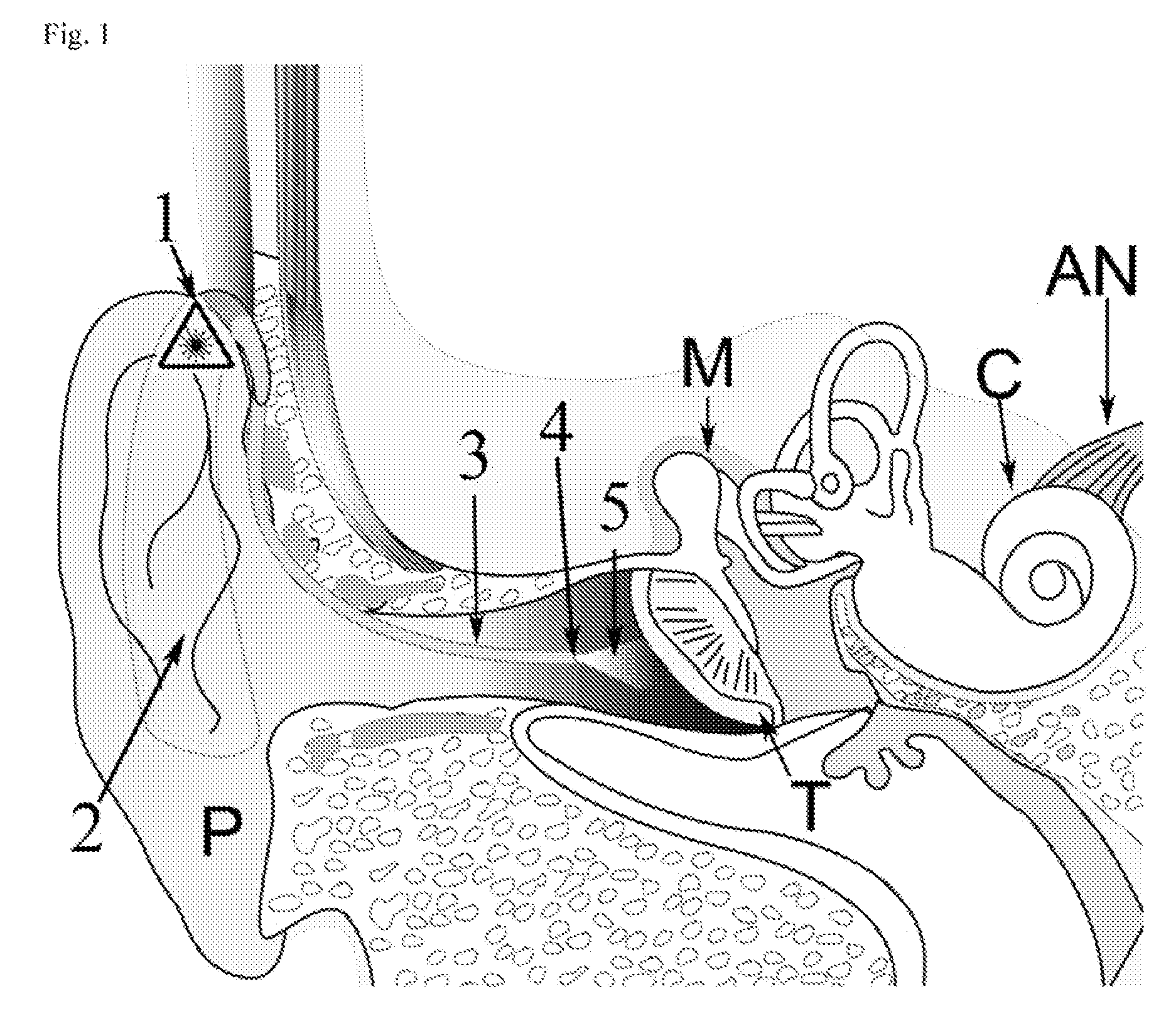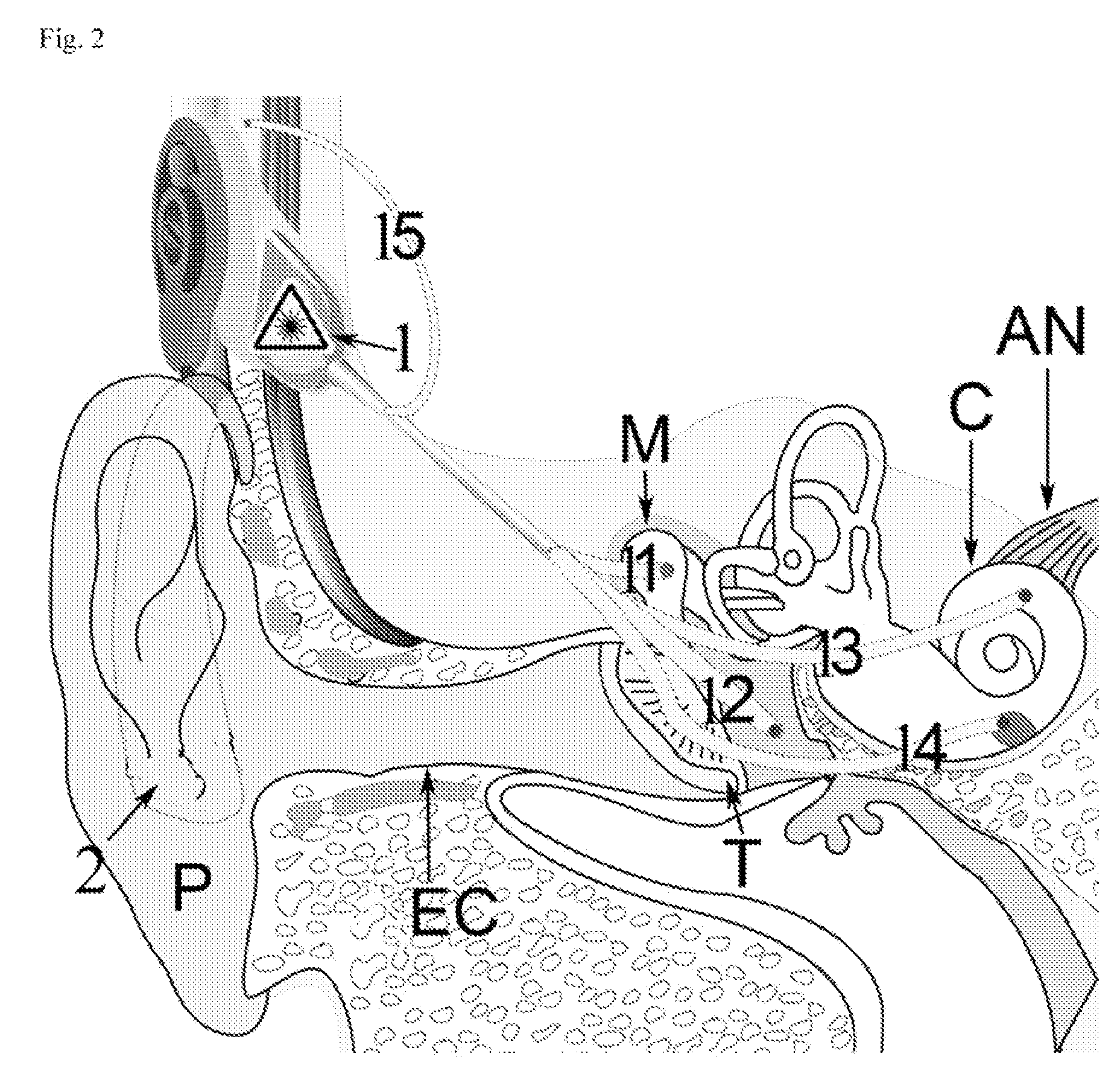[0023]In contrast to
state of art devices using rigidly mechanically coupled vibration generators to introduce vibration signals to a structure of the ear, the embodiments of the invention surprisingly demonstrate that pulsed
light irradiation conducted to the output surface of an
optical path, which output surface is dimensioned for arrangement adjacent and in a spacing from the
target site, is sufficient to generate vibration signals within a
target site without direct mechanical
coupling of the device to the
target site. Whereas
state of art devices use a
transducer which emits acoustic sound vibration with direct attachment of the transducer to a bony structure or to the tympanic membrane, the device of the invention contains an
optical path essentially consisting of a laser, optionally coupled to an optical fibre, that is dimensioned for arrangement of the output surface of the optical path adjacent but not contacting a bony body section that is rigidly fixed and / or mechanically coupled to the cochlea. Accordingly, the invention shows that a device having a laser or another pulsed
light source, optionally coupled to an optical fibre, the output surface, e.g. of the end section of which is dimensioned for arrangement adjacent a target site, and not in contact with the target site, effects the generation of auditory nervous signals in dependence on frequency modulated pulsed
light irradiation conducted to the output surface of the optical path.
[0024]The device and process of the invention have the
advantage over
state of art devices which are disposed to transmit vibration signals across a mechanical
coupling of a transducer to a target site of the ear in that no direct contact and no direct mechanical
coupling of the end section of the optic fibre to a target site is necessary, and should in fact be avoided to reduce undesired pulses and other side effects, e.g. infections, the risk of loss of mechanical coupling, the risk of perforation of
anatomical structures like the tympanic membrane, the
meninges due to mechanical stress caused by the mechanical contact or positioning procedure. Due to the spacing of the output surface of the optical path from the target site, there is no need for precise placement of a part of the device to a target site, and no need (or a
mechanical bond between a part of the device and a target site. Accordingly, the device and process of the invention allow for a simple localisation of the output surface of the optical path, e.g. of the output surface of the laser or of the end section of the optic fibre adjacent a target site without requirement for mechanical contact, and in addition avoid a change of the vibration characteristics of the target site and of the
hearing perception, because no
mechanical bond is made, and because no weight is added to an element of the natural vibration transduction pathway.
[0028]Due to the optical path of the device being dimensioned to terminate in at least one output surface, e.g. in the output surface of the laser or in the output surface of an end section of an optical fibre coupled to the laser or another pulsed
light source, adjacent to but not directly contacting their target sites, the device of the invention in general is adapted to avoid direct mechanical stimulation of the cochlea or of elements of the natural vibration transduction pathway that are mechanically linked to the cochlea. As a consequence of the spacing of the output surface of the optical path from the target site, no
mechanical load is imparted from the device to the target site, reducing interfering mechanical stimuli. For converting sound into a modulated pulsed
light irradiation, the laser or another pulsed
light source is preferably controlled by a modulator to generate irradiation specific for a pre-determined range of sound-frequencies.
[0036]Preferably, the optical fibres have a non-transparent circumferential outer surface, e.g. provided by a non-transparent
coating or a non-transparent
radial surface structure. The cross-sectional fibre surface, which is preferably perpendicular to the longitudinal axis of the fibre at the end of the fibre which is dimensioned for arrangement adjacent to the target site, can be optically transparent, and optionally it has reduced transparency, e.g. a
coating by a material of reduced
optical transparency or a non-transparent material. This embodiment has been found to effectively generate
mechanical vibration at the target site by irradiation exiting the output surface at the end section of the fibre.
[0037]The output surface of the optical path, e.g. the cross-sectional surface of the end section of the optical fibre, preferably is in an angle of 0° to 90°, to the longitudinal axis of the optical path, e.g. to the optical fibre, so that the irradiation transmitted along the optical path can exit the output surface or can be reflected by the output surface and irradiate in an angle to the axis of the optical path, e.g. between 0° mid 120°. It has been found in animal experiments that laser irradiation transmitted to the end sections of the optical fibres adjacent target sites according to the invention, e.g. to the tympanic membrane, members of the
ossicular chain, or to the outside of the cochlea, e.g. to the window membrane, elicits auditory
brainstem responses (ABR) for laser energy levels in the range of 1-30 μJ / pulse.
Prolonged exposure of these target sites to the pulsed irradiation emitted from the device of the invention did not produce significant cellular damage but resulted in the veneration of ABR in accordance with irradiation, and essentially without loss of ABR amplitudes over extended periods of time, indicating that the device of the invention is suitable for long-term use as a hearing aid device. From the animal experiments it can be deduced that for induction of vibration signals in target sites of the invention it is preferred that the laser and the optical fibres are set to emit a maximum laser
pulse energy in the range of about 1 nJ to 1 mJ, preferably in the range of about 1 nJ to 50 μJ, e.g. at a
pulse frequency of 1 Hz to 10 MHz, e.g. at pulse durations in the range of about 1 fs to 1 ms, preferably to 1 μs, preferably in the range of 1 fs to 1 ns. Due to the spatial confinement of irradiation conducted to the end sections of the optical fibres, and due to the
dimensioning of the optical fibres for their positioning adjacent pre-determined target sites according to the invention, the device of the invention has the
advantage of combining the excitation of the target site in accordance with the modulation of the irradiation, and hence of frequency-specific excitation of the auditory nerve, with a tolerable burden on the target sites, i.e. a non-destructive excitation of mechanically coupled elements of the vibration
signal transduction pathway, allowing for frequency specific cochlear stimulation and for its long-term use.
 Login to View More
Login to View More 


